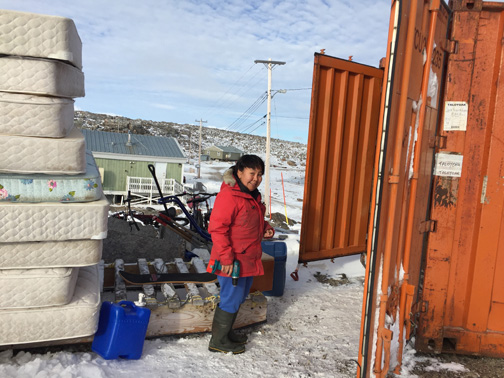





Ontario Vincentians adopt Nunavut communitiesMay 3, 2017 by By Deborah Gyapong, Canadian Catholic News 
A resident of Taloyoak stands by an open sea container after a shipment was sent from the Society of St. Vincent de Paul Society in Ontario. (Photo by Rev. Lukasz Zajac) OTTAWA (CCN) — Ontario members of the Society of St. Vincent de Paul have adopted five Nunavut communities to support through the shipments of food and other goods. Parishes in Ottawa, Windsor, St. Catharine’s, Kitchener-Waterloo and elsewhere are collecting needed items to fill sea containers that will go to Rankin Inlet, Whale Cove, Gjoa Haven, Taloyoak and Naujaat, formerly Repulse Bay. “We’ve got a great committee going on it,” said Bernie Hartlin of Holy Redeemer Parish in Ottawa, and co-ordinator for Ottawa’s English-speaking Society members. They are now filling one of two sea containers Ottawa members will fill. “Everyone’s being fired up around it.” Pegg Leroux, one of the two vice-presidents for the Society’s Ontario region, has spearheaded Ontario’s involvement. Ontario decided to take on Nunavut at the region’s annual general assembly (AGA) in 2015. “We only had an inkling of what the situation is,” she said. In October 2015 Leroux visited Rankin Inlet, a regional hub of more than 3,000 people, and Whale Cove, a small community of about 400. Her 10 days there were “a learning experience,” Leroux said. “I listened to their daily lives. I listened to the differences in our northern brothers and sisters.” While she knows there are poor in the south, the desperate situation in the north “has become a part of every wakeful moment I’ve had since then.” She has been up three times now, “just to learn.” “What I learned from my brothers and sisters up north was the biggest thing we have to establish was trust,” she said. “There have been so many promises made, either not lived up to or broken promises.” In 2016, the Society was able to send up two sea containers. “Last year, I lost my kitchen, my dining room, my basement and my garage to food,” she said. They were also able to send some shipments by plane. Ontario has followed the template created by Peter Ouellette, a Vincentian in Edmonton. Ouellette was able to mentor Leroux for about six months. The North of 60 project started through a personal relationship between Eileen Orysiuk and Sister Faye Trombley who organized friends and family to put things into a sea container for Tuktoyaktut, N.W.T., Ouellette said. “I came in the second year they were working on this. Eileen was on her deathbed. She said to me, ‘Don’t forget the north.’ She made me promise and I took that to heart.” Ouellette moved aggressively to enlist corporate donations from trucking companies, storage companies and others to facilitate the project. After the Vincentians took over, they increased donations to three communities by the next year. They now serve 12. He hopes as Vincentians in Ontario, Quebec and elsewhere catch the vision, the Society will have the capacity to assist all of the people in need in the Arctic. “When we start with a community we don’t accept failure, so it’s a long term commitment,” he said. “We are hoping to move from providing the assistance to helping them change with a hand up in various aspects of their life and that has worked.” The Society was able to initiate a driver’s training program through a donated Jeep Cherokee that helped people get their license and through that government identification and help at getting a better job. “Systemic change is the long-term objective,” Ouellette said. The program is primarily one of food security and nothing is shipped that is not requested, he said. During a trip to Nunavut last May, Leroux asked what people wished to receive for Christmas. “The first thing out of their mouth was flour, then sugar, baking powder,” she said. “I kept writing.” “They could have asked for the sun, the moon and the stars, but they asked for essential food items so they could make bread — bannock.” Leroux went into the stores to take pictures of how much items cost. A 2.5 kg bag of flour costs nearly $32, she said. Three boxes of Kleenex go for $17.99. Toilet paper is also exorbitant, because most items have to be flown in and even though these items are light, they are bulky. “They’ve been paying these prices for years,” Leroux said. “The parents can be hungry for days to make sure their children eat.” At Ontario’s fall AGA, Leroux gave a PowerPoint demonstration on how to stuff a container and communities stepped forward. Ottawa will send two sea containers to Rankin Inlet; St. Catharine’s will send one to Naujaat; and Windsor/Essex will send one to Gjoa Haven, Leroux said. Containers will also go to Taloyoak and Whale Cove through donations from Society conferences across the province. Some of these communities can only receive sea shipments once a year; the rest of the time they are supplied by plane, thus making the goods so expensive, she said. “I represent a lot of people when I go up there from Ontario,” Leroux said. “I tell all those brothers and sisters stuffing containers, ‘Put your picture in. Say, hi and one day I hope to meet you.’ ” We call each other brothers and sisters because “you are family and you don’t give up on family,” Leroux said. “I am hoping we will instil that with our brothers and sisters up north.” InuitOntario Vincentians adopt Nunavut communities
|







